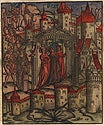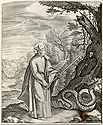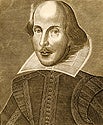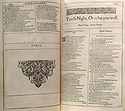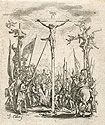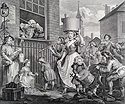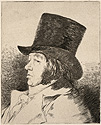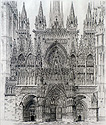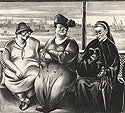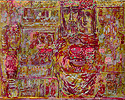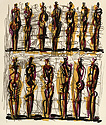This exhibition celebrates the extraordinary legacy of Georgetown’s Print Curator Emeritus, Rev. Joseph A. Haller, S.J. (1920 – 2008). After his retirement as University Treasurer in the mid 1970s, Father Haller had the vision to establish a broad-based print collection to augment Georgetown’s academic programs in teaching, scholarship and outreach. The collection today numbers approximately 12,000 and is one of the finest of its kind at an institution of higher education. As the late artist Jacob Kainen wrote in a letter to Fr. Haller in 2000: “I hadn’t realized how extensive your collection was. Certainly you have been more active than almost every museum curator in the country, and with less time and money to bank on.”
Born in Pittsburgh, Fr. Haller earned a degree in business administration at Duquesne University and worked briefly in the accounting department of U.S. Steel. He entered the Society of Jesus on September 7, 1945 and studied at the Novitiate of St. Isaac Jogues in Wernersville, Pennsylvania, St. Louis University, and Woodstock College. After earning his master’s degree in economics at St. Louis, Fr. Haller spent a year teaching economics and accounting at Georgetown University and Jesuit universities in West Virginia and Pennsylvania. Fr. Haller returned to Georgetown in 1959 and taught economics for another three years, then served as treasurer from 1962-1971.
Initially guided by Bethesda Art Gallery owners Betty and Douglas Duffy, Fr. Haller became enchanted with the affordability (at the time) of fine prints, their value as original works of art, and their potential for teaching and inspiring students. With modest means, Fr. Haller cautiously purchased his first print, a lithograph by Marion Greenwood (see case E7) in 1976. From a nucleus of prints, he began systematically expanding through purchase (up to $100 in those days), by exchange with other institutions (such as the Smithsonian and the Library of Congress), and by attracting donations. By 1982 Fr. Haller was able to mount his first exhibition, In Celebration of American Industry, to coincide with the 25th anniversary of Georgetown’s school of business. A second exhibition in the summer of 1983 was entitled Vacation Reveries.
As the Graphic Arts Collection continued to grow, it focused on in-depth representation of individual artists, together with larger collections built around groups or “schools” of artists. By the mid-1980s Georgetown acquired several significant collections: the Isac Friedlander Collection of over 100 prints donated by the artist’s widow; the Murphy Collection formed by Philadelphia collector James P.J. Murphy featuring some 200 prints by major American printmakers of the 1930s and ’40s (particularly the Regionalists Thomas Hart Benton, Grant Wood and John Steuart Curry); and the James W. Elder self-portrait collection. In addition to these was Fr. Haller’s Jesuit Collection, which he formed over the years to highlight American printmaking in the mid-twentieth century. During this period of rapid growth, exhibitions increased to focus on single artists such as: Lester Hornby, Prentiss Taylor, Philip Reisman, and William E.C. Morgan.
In addition to in-depth representation, the collection also features important prints by famous as well as lesser-known artists, as seen in this exhibition. Fr. Haller also concentrated on Washington area artists, as well as artists of other nations and earlier epochs, providing a more global context for the study of American prints.
The defining moment came with a generous endowment, in 1985, from Mrs. Elizabeth Fairchild in memory of her late husband, Charles Marvin Fairchild, a Georgetown alumnus and former classmate of Fr. Haller’s. Her gift provided substantial funding for print acquisitions and a special graphic arts gallery within the Library. The Fairchild endowment accounted for purchases made for the Jesuit collection, as well as further group acquisitions. The Fairchild Memorial Gallery was completed in time for the spring 1997 exhibition of Werner Drewes’s woodcuts (case E8).
n 2001 Father Haller was able to realize his dream of using original prints in teaching undergraduate art history. In collaboration with Keyser Family Professor of Art History Elizabeth Prelinger, they presented a unique opportunity for the study of American 20th century prints. Their semester-long, upper-level seminar (ARTH 357) culminated in a student-curated exhibition in Fairchild Gallery. This popular course was repeated in the Fall of 2007 (ARTH 457) with the resulting exhibition This Print Is Your Print, This Print is My Print, with an on-line exhibition archived on the Library’s Web site. Georgetown students selected the prints, researched and wrote the label entries and all text for both exhibitions, and gained invaluable experience in designing and curating an exhibition; skills that will translate into careers in museums, education and the world of fine art. This exhibition draws upon research and writing performed by several former seminar students.
The current exhibition draws from several of the collections mentioned above as well as many others. We invite viewers to consider the history underlying each of these treasures, for the joy of print collecting—as Fr. Haller discovered—lies in the individual stories told through the consummate skill and craftsmanship of their printmakers.
Note:
This introduction is based on the article by Roderick S. Quiroz: “The Extraordinary Graphic Arts Collection at Georgetown University,” published in the The Washington Print Club Quarterly (Spring 1999), pp. 6-8.
See also: “Remembering Father Haller,” in the Library Associates Newsletter, Issue 91 (Spring 2009), pp. 4-5.
Walled Cityscape
Michael Wolgemut (workshop of) (1434 – 1519)
German
c. 1500
Woodcut with hand coloring
184 x 140 mm
Menke Collection
The Liber Chronicarum (more commonly known as the Nuremberg Chronicle) is widely regarded as an outstanding example of early printing, largely due to the quality of its illustrations and masterful typography. Simultaneously printed in Latin and in German editions, it was the most lavishly illustrated book of its time. It was highly popular: approximately twenty-five hundred copies were printed and an unauthorized cheaper version appeared just four years later.
The Liber Chronicarum presents a history of the world from creation to the present day. The work includes the history of the Church, secular history, classical antiquity, and medieval and contemporary events mixed with fables, myths and legends. Many famous people and cities from throughout the world are depicted, but illustrations were often repeated in the book with only the labels changed; of over eighteen hundred illustrations there are fewer than seven hundred unique images.
This leaf from the Chronicarum’s German edition is the oldest print in Georgetown’s art collection.
De vita et morib. Ignatii Loiolae
Giovanni Pietro Maffei (1536? – 1603)
Romae: Apud Franciscum Zannettum
1585
Special Collections Research Center Rare Books Collections
This three-part biography of Saint Ignatius Loyola (1491 – 1556) by Giovanni Pietro Maffei is bound together with eighty plates by an unidentified engraver illustrating the life of the founder of the Society of Jesus. Printed in 1622, the year of Ignatius’s canonization by Pope Gregory XV, the plates provide a fascinating visual chronicle of the saint’s work and the time in which he lived. This volume belonged to Archbishop John Carroll, founder of Georgetown College in 1789, and Father Haller—proud of its illustrious provenance—enjoyed showing it to scholars and visitors on special occasions. The ownership inscription on the title page (subsequently crossed out) translates from the Latin abbreviation as: John, Bishop of Baltimore. It bears the Georgetown College stamp which was applied to the title page by 1832.
Vita beati P. Ignatii Loiolae Societatis Iesv Fvndatoris
Rome
1622
Special Collections Research Center Rare Books Collections
Two of the eighty engravings bound with Maffei’s Life of St. Ignatius: title page and a scene depicting Ignatius’s encounter with a demonic vision of a serpent.
Portrait from the title page of Mr. William Shakespeares Comedies, Histories, & Tragedies, Published According to the True Originall Copies [facsimile]
Martin Droeshout (b. 1601 – d. after 1639)
British / Belgian
London: Isaac Jaggard and E. Blount
1623
Special Collections Research Center Rare Books Collections
Displayed in the exhibition is a reproduction of the title leaf from Georgetown’s First Folio of Shakespeare’s plays and a 1910 facsimile edition. Only a few over two hundred copies of The First Folio are extant today—most of them with slight imperfections. Georgetown’s copy lacks only its original title page and last leaf (the engraved portrait is inserted from a Fourth Folio edition). Through careful research, scholars have proven that the text in each copy of the First Folio varies slightly. Of the thirty-six plays published herein, seventeen appear in print for the first time. Georgetown’s copy, which includes the bookplate of a previous owner who acquired the volume in 1888, was purchased from the estate of John Vinton Dahlgren, through negotiations with Father Haller in 1964.
Mr. William Shakespeares Comedies, Histories, & Tragedies, Faithfully Reproduced in Facsimile from the Edition of 1623
William Shakespeare (c. 1564 – 1616)
British
London: Methuen & Co. Inc.
1919
Special Collections Research Center Rare Books Collections
Small Passion of Christ
Jacques Callot (c. 1592 – 1635)
French
c. 1623
(suite of 12 etchings)
Gift of John Stocker
Jacques Callot’s technical innovations in the process of etching on copper enabled future generations—including Rembrandt and Goya—to exploit the expressive potential of the medium while replicating the effects of free-hand drawing. Callot’s discovery of a hard ground made of mastic and linseed oil adhered more effectively to the metal plate during the acid biting process, and he was the first to use repeated immersions in the acid bath, resulting in realistic spatial recession through gradual transitions from light to shadow.
Callot is best known for his depictions of everyday life and documentation of the great theatrical court festivals of his time. He studied for several years in Rome, then worked at the Medici court in Florence where he resided at the Uffizi Palace. During this period Callot completed a series of fifty scenes called The Caprices, about the size of visiting cards, the first series of etchings employing his new-found techniques: hard ground varnish over copper (as opposed to silver) plates, while using the aid of a double magnifying glass.
The series of etched miniatures shown here, known as The Small Passion, exemplifies Callot’s incredible technical mastery in its exquisite detail and control over the medium. Considered one of his finest religious works, The Small Passion was created following Callot’s return to his native Nancy, capital of the Duchy of Lorraine, in 1623. At the time of donation, this series was missing the ninth plate (depicting Christ Presented to the People); hence a reproduction is included in the exhibition for visual reference.
The Golf Player
Rembrandt Harmenszoon van Rijn (1606 – 1669)
Dutch
1654
Etching
96 x 144 mm
Gift of Adam D. Stolpen (L 1973)
Widely regarded as the greatest printmaker of all time, Rembrandt’s sensitivity to the etching medium created some of the most poignant, timeless and enchanting graphic images universally prized to this day. Beginning in 1626 with The Rest on the Flight into Egypt, Rembrandt created some two hundred ninety etched plates, predominantly biblical in subject matter, but also including many self-portraits, everyday scenes, commissioned portraits, landscapes and figure studies. An innovator and constant tinkerer, Rembrandt began adding drypoint lines over etched ones, creating a smoky quality when printed known as “burr.” This tonal characteristic, unique to Rembrandt at that time, is one of the prized characteristics of his etched works. Habitually re-working his plates until he was satisfied with the results, he occasionally made as many as eight or nine separate states as he kept adding and retouching the etched areas of the copper plate after each printing.
The canon of Rembrandt etchings was first presented en masse in Adam Bartsch’s catalogue raisonnée, published in Vienna in 1797. Bartsch assigned a number to each etching, which scholars still use in identifying Rembrandt prints. The Golf Player is commonly known as B125. After Rembrandt’s death, the plates were sold and reprinted over the course of three centuries. These editions are known by the name of the dealer who published them: Pierre Mariette in the 17th century; Charles Henri Watelet (who began the regrettable practice of re-touching the plates as they wore down) in the eighteenth century; Pierre François Basan purchased Watelet’s plates and published a recueil of eighty between 1789 and 1797; Auguste Jean re-issued the recueil around 1810 (with heavy wear to the plates evident in the impressions); and Alvin Beaumont and Michel Bernard published a new edition in 1906. The vast majority of extant plates (some eighty-one) are now in the collection of the Bibliothèque Nationale in Paris. Determining which impression one has is an exercise in connoisseurship that often requires close comparison with a lifetime impression, usually held in museum collections.
The Enraged Musician (3rd state)
William Hogarth (1697 – 1764)
British
1741
Engraving
331 x 397 mm
Donor unknown
William Hogarth, originator of the satirical tradition in British graphic art, is known for his moralizing narrative series such as A Harlot’s Progress (1732), A Rake’s Progress (1735), Marriage à la Mode (1745), and Industry and Idleness (1747). This engraving of The Enraged Musician was conceived as a companion piece to his print entitled The Distressed Poet, both copied from Hogarth’s original paintings. Capturing visually the din of London street life, the artist populated his scene with various noise-making characters and creatures whose combined efforts have thwarted a court musician at an open window from his practice for an upcoming performance of the Beggars Opera. The composition pivots around the central figure of a graceful milkmaid, her mouth open in song. In his three-volume biography, Ronald Paulson proposes the theme of nature versus art in contrasting the purity of the milkmaid with the affectations of the foreign violinist: “Her beauty and grace are surely intended to suggest that her voice, which among the sounds of nature is art, is more beautiful than the musician’s violin because less constricted by conventions.”
Lord Baltimore and the Group of Legislators
James Barry (1741 – 1806)
British
1793
Etching and engraving; of 1808
740 x 475 mm
Purchase 1994
This magnificent 1793 engraving and etching by Royal Academy professor James Barry is the artist’s attempt to correct a historical error he made in his 1783 allegorical mural Elysium and Tartarus. A monumental achievement, the mural was painted over the course of seven years in the Great Room of the Royal Society of Arts in London. In the mural’s central panel Barry paid special tribute to William Penn as the first to bring religious freedom and equality to the British colonies in America.
After completing the Elysium and Tartarus mural, and much to his chagrin, Barry learned that Penn was not the first to plant religious tolerance and freedom in the British colonies: Cecil Calvert, Lord Baltimore, had preceded him. Unable to rectify his error in the huge mural itself, Barry instead created his etching Lord Baltimore and the Group of Legislators, showing William Penn now pushed off to the side as Calvert takes his place before Lycurgus (lawgiver of ancient Sparta) to present the Toleration Act that he wrote, under authority vested in him by the Maryland Charter of 1632, and which was passed by the colony’s General Assembly in 1649.
To give added emphasis to his correction, Barry included in the upper left corner of his print Pope Adrian discussing the episode with a small group of dignitaries, including Benjamin Franklin, Bishop Butler, and the Archbishop of Canterbury. The sixteenth-century Spanish Jesuit Juan de Mariana, often remembered for his writings on tyrannicide, observes the scene from above in the background.
Francisco de Goya y Lucientes, Pintor
Francisco Goya (1746 – 1828)
Spanish
n/d
Etching and aquatint
218 x 151 mm
Elder Collection
The eighty etchings that make up Goya’s most important series of prints Los Caprichos (Caprices, 1799) are antithetical to the spirit of whimsy the term “caprice” usually suggests in music and art. Goya’s use of the term layers ironic humor over a profound indictment of human vice.
Goya depicted himself in the frontispiece to the series, shown here, dressed in the latest fashion and exuding both confidence and disdain. Even before turning to the first plate, the artist has signaled with his own portrait a visual warning of what is to come.
A text in the Biblioteca Nacional in Madrid calls this Goya’s “true self-portrait, in bad humor and with a satirical expression.”
Great Fire of New York
Nicolino Calyo (1799-1884), William James Bennett (1787 – 1844)
Italian / American , American
1836
Aquatint with hand coloring
Purchase
This impressive panoramic view captures with fascinating detail New York’s Great Fire of 1835. It is an aquatint engraving after a painting by the recently immigrated Neapolitan artist Nicolino Calyo, a talented landscape draftsman and eyewitness to the conflagration. Fed by gale winds, the fire destroyed the New York Stock Exchange and most of the buildings on the southeast tip of Manhattan around Wall Street. While water froze in the hoses of the fire fighters, they resorted to exploding neighboring buildings to keep the flames from spreading. Smoke could be seen one hundred miles away, and the disaster was regarded as the most destructive since London’s Great Fire of 1666, but miraculously only two lives were lost.
Calyo also painted an accompanying view of the smoking city as seen from Brooklyn, likewise engraved by W.J. Bennett. The publisher of these views, Lewis P. Clover, effectively touted their ephemeral value in his advertisement: “These beautiful ruins are fast disappearing, and in a few months no vestige of them will be left: in a few years, they will linger as a dream in the memory of the present generation, and the recollection of the most disastrous fire that ever befell this city will, like all earthly things, pass into oblivion.”
American River Ganges
Thomas Nast (1840 – 1902)
American
Published in Harper’s Weekly September 30, 1871 (p. 916)
Wood engraving
Purchase
A major political issue in the 1870s was whether state and municipal governments should allocate funds for religiously affiliated schools, many of which were Roman Catholic. Opponents of the concept considered it to be an attempt by Catholics to destroy the public school system.
Nast’s cartoon was not only part of the cartoonist’s campaign against state aid to parochial schools, but was related to his sustained attack on Boss Tweed and Tammany Hall, the corrupt political machine in New York City. Tweed and his cohorts are portrayed throwing children off the cliff to attacking crocodile-like bishops and leading an allegorical Miss Columbia to the gallows. Nast’s cartoons were instrumental in exposing and publicizing Tweed’s corruption, resulting in the election of numerous opposition candidates in 1871, and Tweed’s arrest and trial soon thereafter.
In 1875, while the issue of Tammany Hall had been resolved, Catholic influence in public schools still rankled and the cartoon was re-published with some amendments. For the 1875 version, Nast replaced Tweed and his associates with generic political thugs and switched the label on the Vatican from “Tammany Hall” to “The Political Roman Catholic Church.” In both instances, Nast’s cartoon was accompanied by articles written by Eugene Lawrence: “The Priests and the Children” (1871) and “The Common Schools and Their Foes” (1875), in which the Catholic hierarchy is bitterly assailed for its alleged assault on the public school system.
The American Art Review: A Journal Devoted to the Practice, Theory, History and Archaeology of Art
Boston: Dana Estes and Charles E. Lauriat
1880
Special Collections Research Center Rare Books Collections
Volume one of this tremendously influential American art periodical, now quite rare, was published with sixteen etched plates. The one shown here is a reproduction of Rubens’s St. Francis Xavier Raising the Dead, one of three altar pieces commissioned for the Church of the Jesuits in Antwerp along with thirty-nine other religious paintings. The etcher, William Unger, was professor of graphic arts at the Vienna Academy and had a long and successful career reproducing the works of contemporary and old master artists. To make his etching, Unger worked from Rubens’s preparatory sketches which were at that time in the Belvedere Gallery in Vienna.
Portrait of a Lady
Frederic Leighton (1830 – 1896)
British
n/d
Lithograph
215 x 137 mm
Rackham Collection
Frederic Leighton was a major painter and sculptor of the British Pre-Raphaelite movement. His paintings of biblical, mythological and historic subjects were prized for their classical form and moralizing content that appealed to contemporary Victorian sensibilities. Leighton was knighted in 1878, became president of the British Royal Academy that same year, and represented his country at the Paris Exhibition of 1900. His house in London is now open to the public as the Leighton House Museum.
This lithograph after a drawing by Leighton may represent Lillie Langtry, the celebrated actress and mistress of the Prince of Wales. Langtry posed on occasion for Leighton, and appears as the right-hand figure in his painted Idyll (c. 1880), inspired by the reclining figures on the Parthenon frieze. The lithograph in Georgetown’s collection was displayed in Father Haller’s 1999 exhibition, British Print-makers of the 1890s. It was donated by Charles and Margaret Rackham, whose substantial collection of over two hundred prints and works on paper is primarily composed of British artists, including major figures such as Frank Brangwyn, David Young Cameron, Augustus John, and John Everett Millais.
Gates of Pedro Miguel (Lock, Panama)
Joseph Pennell (1857 – 1926)
American
1912
Lithograph; ed. 50
564 x 428 mm
Special Collections Research Center Rare Books Collections, Purchase 1996
A pioneering figure in American printmaking, Joseph Pennell became interested in the graphic arts early in life; at the age of twenty he co-founded the Philadelphia Society of Etchers and supported young printmakers long into the twentieth century. Cosmopolitan and curious, Pennell documented his many experiences in Europe and the Americas. Having already ventured to the Isthmus of Panama to witness the historic building of the Panama Canal in 1911, he served on the print jury for the Panama-Pacific International Exhibition in San Francisco in 1915. His series of twenty-eight prints of Panama and the canal construction, regarded as his most important in a vast printmaking oeuvre, were published in Joseph Pennell’s Pictures of the Panama Canal (Lippincott 1912). Displayed here with his monumental lithograph of the Pedro Miguel lock is a fourth edition of the volume from the collection of Georgetown’s Hirst Library, a predecessor—together with Riggs—of today’s Lauinger Library. There are sixty-eight Pennell prints in Georgetown’s collection.
Joseph Pennell’s Pictures of the Panama Canal
Philadelphia: J. B. Lippincott Company
1912
Special Collections Research Center Rare Books Collections
Promenade Deck
Peggy Bacon (1895 – 1987)
American
1920
Drypoint
152 x 213 mm
Purchase 1981
Peggy Bacon, a prominent caricaturist of her social milieu, was on her honeymoon aboard the S.S. New Amsterdam en route to England when she began the sketches that would later form the elaborate drypoint etching Promenade Deck. The plate was purchased by the New Republic magazine in 1924 along with plates by five other American artists including John Sloan, Edward Hopper and John Marin, and published in a portfolio entitled Six American Etchings. As in all of her compositions, the characters populating Promenade Deck were portraits of actual people Bacon observed on the ship, including herself and her husband, the artist Alexander Brook, as the second and third figures (sketching) in the lower right corner.
Soul Mates
Peggy Bacon (1895 – 1987)
1968
Oil on board
305 x 210 mm
Purchase 1978
Father Haller was particularly fond of Peggy Bacon’s Soul Mates, and loved to point out the clever way in which the stooped posture of the old lady was echoed in the gait of her canine companion. The painting was included in a major solo exhibition at the Smithsonian in 1975 and purchased from Kraushaar Gallery in New York along with another oil on masonite entitled Wellfleet Worthy. The Washington Post reported that the eighty year-old Bacon was “witty and incisive, without the demolishing scorn of a political cartoonist… she offers a revealing reflection of society in her time spanning over half a century.”
Lace in Stone, Rouen Cathedral
John Taylor Arms (1887 – 1953)
American
1927
Etching; ed. 100
357 x 288 mm
Gift of Murray Lebwohl
Consummate draftsman John Taylor Arms was fascinated by European Medieval architecture and made it the focus of much of his work. In his goal of expressing the essential spirit of what he believed to be mankind’s most inspired creations, he sought to emulate Piranesi and others whom he felt captured their subjects’ essence and not just their physical appearance. Thus, despite the technical tour de force seen here in Lace in Stone, the overall impression is one of romantic lightness.
In her book Churches of France (New York: Macmillan, 1929), Dorothy Noyes Arms recounts that her husband’s only vantage point from which to make the drawing was on a traffic island in the middle of the main street, for which permission was required from the Chief of Police. Arms found that the Chief was an admirer of his work and already owned two of his etchings, and permission was gladly granted; he was able to complete the drawing in five days. Lace in Stone was donated by Murray Lebwohl in honor of Father Haller’s retirement and eightieth birthday celebration in 2000.
Ferry Boat
Mabel Dwight (1876 – 1955)
American
1930
Lithograph; ed. 60;
258 x 233 mm
Purchase 1983
This humorous lithograph of three incongruous passengers on the Staten Island ferry was included in Father Haller’s final exhibition in 2000, Printmakers A to Z. After training as a painter, Mabel Dwight learned the technique of lithography in Paris at the age of fifty. She soon embraced the medium for its expressive, broad appeal and ability to interpret her world and its shortcomings in the graphic tradition of her favorite artists: Goya, Daumier, Hogarth and Rowlandson. Dwight worked for New York’s Federal Art Project in the late 1930s and wrote a critical essay, “Satire in Art,” for a report on its merits. Ferry Boat is one of Mabel Dwight's delightful satires from this time period, and it was honored as one of the “Fifty Prints of the Year” by the American Institute of Graphic Arts.
Converter at Night
Louise Miller Boyer (1890 – 1976)
American
1934
Drypoint (with aluminum plate)
137 x 112 mm
Gift of Helen Boyer
The Converter at Night shows a steel mill in Pittsburgh in the early 1930s. Here, the monumental Bessemer Converter turns iron into steel in a process made even more dramatic in a night scene. Louise Miller Boyer created this drypoint on a treated aluminum plate, which was much harder than the traditional copper or zinc. She began experimenting with the lighter weight aluminum after Alcoa opened a Pittsburgh mill in 1931. While the harder surface accommodated much larger print editions, it was less forgiving of errors, which could not be burnished out or “erased” as with copper. The two diagonal lines seen on the opposite corners of the Converter plate are cancellation marks, made to prevent unauthorized later impressions from being pulled.
Eight Bridges
Louise Miller Boyer (1890 – 1976)1935
Drypoint
214 x 276 mm
Gift of Helen Boyer
Louise Boyer was born and raised in Father Haller’s native town of Pittsburgh, along the Monongahela River. Many of her works depict subjects dear to his heart: the mills and homes along the riverside, and the social and environmental impact of industry. She devoted a series of twenty drypoints to scenes of Appalachia’s capital between 1932 and 1945, including the images displayed here.
The Boyer collection's approximately four hundred prints, drawings, and other works of art document the activity of Pittsburgh artists Ernest W. Boyer, his wife Louise, and their daughter, Helen King Boyer. Of special interest are the large assemblage of drypoints pulled from anodized aluminum plates by Louise and Helen Boyer, including many of the original plates. Georgetown’s manuscript division also holds the artists’ personal papers as well as those of Louise’s father, a prominent homeopathic physician.
Dream (Mantis Religiosa)
Maurits Cornelis Escher (1898 – 1972)
Dutch
1935
Wood engraving
322 x 241 mm
Menke Collection
Escher’s first exhibition in the United States was a direct result of quintessentially Washingtonian networking. Charles Alldredge (public relations consultant, publicist for author Rachel Carson, and Truman campaign aide) read about Escher in a 1951 issue of Time magazine. Alldredge, fascinated, also sensed an opportunity and immediately wired a bank draft to Escher in Holland to purchase prints.
Alldredge liked the artwork so much that he ordered more for himself and for his friends; he also convinced his friend Franz Bader (managing partner of Whyte’s Bookstore and initiator of the Whyte Gallery which showed local artists) to hold an exhibition of Escher’s work at the gallery.
Escher’s first sale of artwork at the show was the print shown above, which was bought by architect, city planner, and collector Eric F. Menke. In 1981 the print came to Georgetown as part of a bequest from Menke’s estate, along with many other works from his collection and papers relating to his civic career.
And Blessed Be Thy Name
Isac Friedlander (1890 – 1968)
American
1942
Etching; 7/20
328 x 210 mm
Friedlander Collection
The Latvian-born Isac Friedlander had a troubled adolescence under the repressive Russian regime. Arrested for what were seen as anti-czarist political activities, he served four years’ imprisonment for suspicion of murder, but the three classmates arrested with him were executed. (They had been protesting compulsory uniforms and weekend curfews.) After his release, Friedlander traveled to Italy, where he had his only formal art training at the Academy in Rome. In the 1930s, with the help of his cousin Joseph Hirshhorn, Friedlander emigrated to Canada, where he met and married his second wife, Gilda. They soon relocated to New York, where Friedlander became a respected and successful artist and print maker, working primarily in etching and woodcut.
Friedlander’s work emphasizes the imagery of his native Latvia, the urban spectacle of New York during the Depression and the horror of the Holocaust. Some of his best-known works contain religious themes such as the Jewish experience, the Holocaust, and African American church services. Second only to the Hirshhorn’s, Georgetown’s holdings of Friedlander’s prints, donated by his widow and daughter, are the largest in an institutional collection.
Morelia Aqueduct
Prentiss Taylor (1907 – 1991)
American
1942
Lithograph; ed. 35
283 x 380 mm
Taylor Collection
Prentiss Taylor, a third-generation native of Washington, D.C., was a leading figure in the fine arts in this area for the second half of the twentieth century. His early years were spent in New York’s Greenwich Village, where he created designs for the theater and illustrated his friend Langston Hughes’s play Scottsboro Limited and collected poems entitled The Negro Mother and Other Dramatic Recitations. Taylor also created prints for the Public Works of Art Project of the Federal Government during this time. He returned to the nation’s capital in 1935 with a solo exhibition at the Corcoran Gallery. For over a decade beginning in 1943, Taylor innovated and taught art therapy at St. Elizabeth’s hospital and was a friend of the poet Ezra Pound during the latter’s residence there. He also taught painting at American University for twenty years and was active with the Society of American Graphic Artists for over three decades.
Taylor traveled throughout the south and west of America, and this lithograph was inspired by his first visit to Mexico in April, 1940. It was later selected for publication in Albert Reese’s American Prize Prints of the Twentieth Century (1949).
Father Haller greatly admired Taylor’s work and curated a solo exhibition at Georgetown in 1990. He also wrote the foreword to the catalogue raisonné of Taylor’s lithographs by Ingrid Rose and Roderick S. Quiroz, published in 1996. Georgetown University is proud to own the master set of Prentiss Taylor’s lithographic oeuvre of over one hundred forty prints, recently donated by Roderick S. Quiroz.
Hungarian American Farm
Grace Albee (1890 – 1985)
American
1943
Wood engraving; ed. 100
153 x 320 mm
Cohn Collection
Grace Albee was an important American Regionalist printmaker of the twentieth century. Her career spanned more than sixty years, during which she produced more than two hundred and fifty prints from linocuts, woodcuts, and wood engravings. These graphic works record her careful observations of her surroundings near the various locales in which she lived: Providence, Paris, New York, Bucks County, Pennsylvania, and finally in Barrington and Bristol, Rhode Island. Albee is known for her intricately carved wood engravings of rustic Pennsylvania barns and the rural countryside during the 1940s and 50s, such as this 1943 image of a Hungarian American farm.
During the decades prior to the Second World War, Albee won prestigious awards and was showered with accolades from art critics. Through numerous purchase prizes, her prints were accessioned into museum collections throughout the United States and abroad. In 1946 Albee was honored as the first female graphic artist to attain full membership in the prestigious National Academy of Design.
Father Haller arranged with Albee collectors Julius and Marjorie Cohn to purchase over time a total of one hundred forty-eight works, including preparatory drawings and trial proofs. A retrospective of her career at the Women’s Museum in 1999 drew heavily from Georgetown’s collection. An exhibition at Georgetown in 2005 was guest curated by Christina Weyl, a senior in the American Studies department. From her thesis, Ms. Weyl went on to publish a related article on Grace Albee in the Print Quarterly (XXIV, No. 2, 2007).
Tehuantepec River
Miguel Covarrubias (1904 – 1957)
Mexican
c. 1946
Lithograph
312 x 232 mm
Murphy Collection
The Mexican-born illustrator, caricaturist and mural painter Miguel Covarrubias came to New York in 1924 on a grant from the Mexican government. He was just nineteen years old, but already well-known as a caricature artist in Mexico, Cuba, and Central and South America. In New York, photographer Carl Van Vechten introduced him to the “Smart Set” which included Vanity Fair editor Frank Crowninshield, who lost no time in commissioning Covarrubias. Up until 1936, Covarrubias’s witty, stylized caricatures were featured regularly in the periodical, including on several distinctive covers.
Successfully self-trained as an anthropologist as well as an artist, he won a Guggenheim fellowship in 1930 to travel to Bali and document the people and their ways of life. After returning to Mexico in the early 1940s, Covarrubias wrote and illustrated an account of the Tehuantepec region, Mexico South (1946). A contemporary review describes it as
…a rich and profound book. The facts are all there—the facts of race, geography, art, play, history, work, food, and religion—but they are illuminated and arranged by the artist’s imaginative insight. The result is the evocation of a land and its people. Add to that his warmly luminous pictures and you have one of those, all too infrequent, happy marriages of text and picture.
Frontispiece illustration from Mexico South: The Isthmus of Tehuantepec
New York: Alfred A. Knopf
1946
Special Collections Research Center Rare Books Collections
Two Nudes
Charles Francis Quest (1904 – 1993)
American
1948
Wood engraving (with block); 11/25
302 x 225 mm
Quest Collection
Painter and printmaker Charles Quest was a native of St. Louis, Missouri, and studied at the Washington University School of Fine Arts where he later taught from 1944 to 1971. He and his young wife, also an artist, studied in France briefly before the stock market crash necessitated their return home. Quest participated in the ensuing New Deal government-sponsored programs such as the Public Works of Art Project and the WPA, and painted murals in several public buildings in his hometown. He began studying woodcut and engraving through published manuals on his own around 1940. The stark graphic effects of the wood engraved medium were ideally suited to convey Quest’s responses to the tensions of the Second World War. In 1951 he was honored with an invitation to exhibit his prints in the Smithsonian’s Graphic Arts Division.
An exhibition of Quest’s work at the Bethesda Art Gallery in 1983 attracted the interest of Father Haller, who began acquiring his prints for the University’s collection. In 1990 Georgetown became the grateful recipient of a large trove of Quest’s art work including prints, drawings, paintings, sculpture and stained glass, as well as his archive of correspondence and professional memorabilia. These extensive holdings, including some two hundred sixty fine prints, were highlighted in an exhibition here in 2002.
The Avenue
Jacob Kainen (1909 – 2001)
American
1948
Etching; ed. 25
200 x 157 mm
Purchase 2007
Jacob Kainen was the acknowledged dean of the Washington art community up until his death in 2001. Born in Connecticut to immigrants from Russia, Kainen was established in the New York art scene before moving to Washington in 1942 to become the first curator of prints for the Smithsonian Institution, a position he held until 1969. While in New York, Kainen joined the graphic art division of the WPA Federal Arts Project which enabled him to work with very skilled, seasoned print makers and to experiment with various techniques. Kainen’s prints, largely abandoned during his tenure at the Smithsonian, reflect his interest in urban imagery. The Avenue recalls the topsy-turvy perspective of John Marin’s New York views, while the doodled swirls and geometric forms forecast the full-fledged abstraction of Kainen’s later prints.
Jacob Kainen helped found the Washington Print Club in 1964 and, like Father Haller, was a long-standing advisor to this membership organization of collectors, dealers, curators, printmakers and others interested in fine prints. Father Haller had collected nine prints by Jacob Kainen before celebrating his retirement and eightieth birthday in 2000. At that occasion, Kainen more than tripled that amount with a generous donation in honor of his friend.
This Beginning of Miracles
Corita Kent (1918 – 1986)
American
1953
Serigraph; ed. 210
394 x 493 mm
Purchase 1984
Sister Mary Corita (born Frances Kent) gained international fame for her vibrant serigraphs during the 1960s and 1970s. Her artwork, with its messages of love and peace, was particularly popular—and controversial—during the social upheavals of the time. She expressed her political activism through art, saying “I am not brave enough to not pay my income tax and risk going to jail. But I can say rather freely what I want to say with my art.”
By the 1960s, Kent was using popular culture (such as song lyrics and advertising slogans) as raw material for her meaning-filled bursts of text and color. Her earliest works, however, were largely iconographic, borrowing phrases and depicting images from the Bible.
This Beginning of Miracles is from this early period, illustrating a verse from the book of John (2:11) in which Jesus, at a wedding banquet, turns water into wine when the host’s supply of wine has run out. Performed at the very beginning of Jesus’s ministry, this first miracle served to galvanize the belief of the disciples in addition to extending the wedding celebration.
Voodoo Dancers
Marion Greenwood (1909 – 1970)
American
1957
Lithograph; 4/15
240 x 380 mm
Purchase 1976
This print depicting dancers and drummers in a West Indian temple represents the beginning of Georgetown’s fine prints collection: it was the very first print Father Haller purchased, from the Bethesda Art Gallery, in 1976.
Artist Marion Greenwood, arguably one of America’s greatest twentieth century women artists, left school at the age of fifteen to study painting and printmaking at the Art Students League of New York. She then completed her education at the Academie Colarossi in Paris.
At the age of twenty-two, Greenwood traveled to the American Southwest to paint Navajo Indians. A year later she was living and working in Mexico, where her murals brought her work to the attention of the Mexican President and Mexico’s most famous artist, José Clemente Orozco. Greenwood’s work in Mexico made her reputation in the United States, and when she returned to America in 1936 the government frequently commissioned her for public murals. Stimulated by the exotic and the ethnic, Greenwood continued to find inspiration for her work in travels to the West Indies, North Africa, India, Hong Kong, China and Europe.
Beginning in the 1940s, Greenwood worked for and exhibited her art with the Associated American Artists of New York. The AAA commissioned original graphic art from such great American masters as Grant Wood, Thomas Hart Benton, Reginald Marsh and many others. From 1950 until her death in 1970, original lithography became as important in Greenwood’s art as easel painting and murals.
Heads, Figures & Ideas (with frontispiece lithograph Thirteen Standing Figures)
Henry Moore (1898 – 1986)
British
London: George Rainbird/New York: New York Graphic Society
1958
Lithograph; ed. 150
361 x 250 mm
Special Collections Research Center Rare Books Collections
“Thirteen Standing Figures” was produced as part of a special edition of the book Heads, Figures & Ideas, a joint project between the New York Graphic Society in America and George Rainbird Ltd. in Henry Moore’s native England. The book was published at the height of Moore’s popularity as a sculptor, and includes facsimile pages from his sketchbooks. Included are his interpretations of Etruscan sculpture—which strongly influenced his own work—and also preliminary sketches for his largest commission to date, for the UNESCO headquarters in Paris.
Poster for the Alex Maguy Gallery
Pablo Picasso (1881 – 1973)
Spanish
1968
Lithograph with crayon additions
205 x 141 mm
Gift of Adam D. Stolpen (L 1973)
This lithographic poster was designed by Picasso to publicize his exhibition of seven major paintings at the Alex Maguy Gallery in Paris in June of 1962. He drew the image on transfer papers that were applied to the lithographic stones and printed in three colors at the world-famous Mourlot printing studios. On this poster, Picasso made other additions in crayon, altering the right eye and the hair of his figure. The underlined signature in black is part of the lithograph, and beneath that is Picasso’s original signature in brown crayon.
Self Portrait
Thomas Hart Benton (1889 – 1975)
American
1972
Lithograph; ed. 300
498 x 350 mm
Elder Collection
The son of a Missouri congressman, Thomas Hart Benton defied family tradition to pursue a career in art. Though he studied in Chicago and Paris, it was upon his return to his hometown of Neosho, Missouri, that Benton developed his uniquely American style. Gaining recognition in the 1920s for epic American history paintings, he received several important public mural commissions during the Depression and into the following decade. In the 1930s Benton became identified as a Regionalist artist together with Grant Wood and John Steuart Curry. Shunning the effects of industrialization and modernism that characterized the prevailing Art Deco design, the Regionalists embraced rural subjects idealizing traditional American scenes and themes.
This self-portrait, distributed by the Associated American Artists gallery in New York, was based on a painting Benton made in 1970. In his classical pose beside his easel, Benton—consciously or not—places himself within the tradition of great Western artists. It is part of the James Elder self-portrait collection, judiciously negotiated by Father Haller, which includes approximately four hundred fifty self-portraits by three hundred thirty artists, with a focus on 20th century Americans and local area artists. Elder was a reference and rare book librarian at the Library of Congress, and an avid print collector. At his death in 1981 he had accumulated more than a thousand prints in his Adams Morgan apartment, and a major exhibition was mounted at the Athenaeum in Alexandria, Virginia in 1984.
The Adventurer
Werner Drewes (1899 – 1985)
American
1975
Woodcut; 11/XL
403 x 282 mm
Purchase 1978 for the Drewes Collection
Born in Canig, Germany, Werner Drewes studied at the Bauhaus school of avant-garde art and architecture under Paul Klee. In 1930 he immigrated to the United States and almost immediately helped found the New York-based organization of American Abstract Artists. For almost twenty years he taught at the Washington University in St. Louis, Missouri, where he became friends with fellow printmaker Charles Quest, represented in case E5 on this wall.
Throughout his career, Drewes worked predominantly with abstract color woodcuts. The medium of the woodcut allowed him complete involvement in the printing process; instead of sending his creations to a master printer or running them through a press, Drewes used the back of a spoon to transfer the image onto paper. The artist created this impression by printing the sheet of paper three times, with separate blocks inked for each color. With donations from the artist’s son and from Charles Quest, Georgetown owns sixty-nine Drewes prints; twenty-six of them were exhibited by Father Haller in 1997.
Woolworth Building
Frederick W. Mershimer (b. 1958)
American
1989
Mezzotint; 35/100
298 x 227 mm
Purchase 1989
Creating a mezzotint is an arduous and exacting process that enables the artist to capture shades and tones of light and dark, as contrasted with the crisp sharp lines associated with engravings and etchings. In mezzotint, the entire surface of a metal plate is first covered with a multitude of pin-sized pits that enables the plate to hold ink. If the print were pulled at this point, the result would be a rich, velvety black throughout. To create the image, a smooth metal tool called a burnisher is rubbed over the plate to smooth desired areas of the pitted surface, where light will be revealed when the print is pulled.
A modern master of this technically demanding process, Frederick Mershimer graduated from Pittsburgh’s Carnegie Mellon University in 1980, with a major in painting. He moved to New York in 1982 and studied at Parsons School of Design, the Pratt Graphics Center, and the Manhattan Graphics Center, further developing his talents in fine printmaking. Always interested in the problems of rendering light, naturalism and illusion, Mershimer has focused on New York architecture in many of his prints. Georgetown holds the largest institutional collection of Mershimer’s works, with a total of twenty-six prints, and mounted an exhibition of them in 1992. In celebration of the publication of his catalogue raisonné, the artist returned last year to present a talk and demonstration of the mezzotint process.

